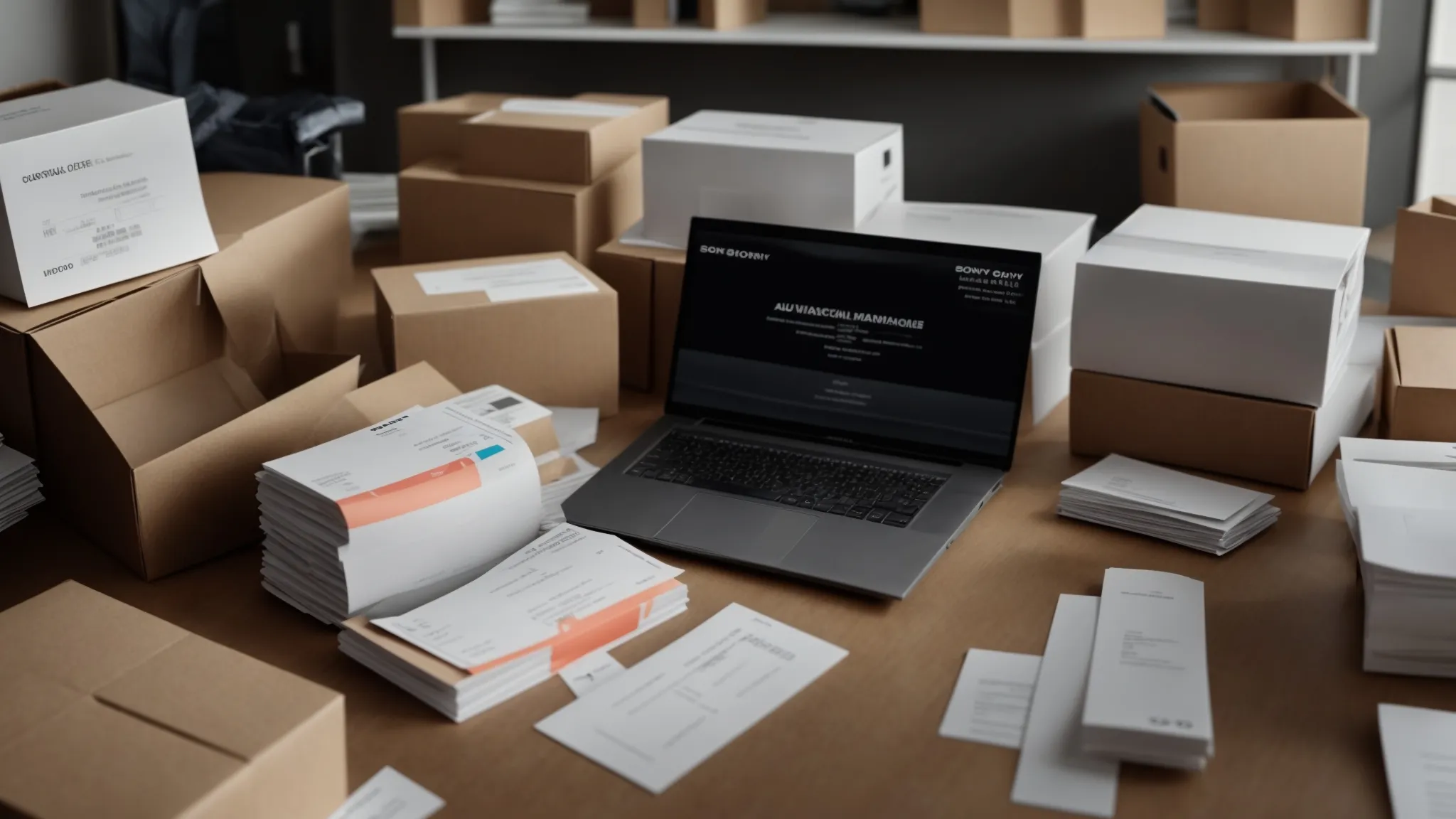Ordering the wrong type of cheques can be frustrating, especially for small business owners relying on accurate financial tools. This guide will help readers identify mistakes, evaluate their options, and contact customer service for an effective resolution. By following these steps, readers will gain clarity on how to correct their order and prevent future issues. Understanding how this process works can save time, money, and potential fraud risks associated with incorrect cheque usage. Engaging with this content will empower readers to manage their cheque orders effectively, ensuring smooth mobile banking transactions and enhanced confidence in their financial operations.
Identify the Mistake in Your Cheque Order

Begin by checking the details of the order confirmation to identify any discrepancies. Compare the ordered cheques with required specifications, such as those for a savings account or bank account, ensuring they meet your needs. Pay attention to usage guidelines relevant to invoices, debt payments, and interest calculations. Understanding the importance of correct cheque types helps prevent future ordering mistakes.
Check the Details of Your Order Confirmation
Reviewing the details of the order confirmation is a crucial first step in identifying any mistakes with cheques. Customers should ensure that the cheque specifications match their intended use, particularly if they are for a deposit account. When verifying the order, it’s important to confirm that the cheque type aligns with the requirements for cash payments, as incorrect types can lead to complications with processing transactions.
Additionally, using online banking or a mobile banking app can enhance this confirmation process. Customers can quickly cross-reference their order with necessary bank guidelines, ensuring that the cheques will work smoothly for future deposits and payments. This attention to detail not only helps resolve current issues but also minimizes the chance of errors in future orders, fostering a more efficient cheque management experience.
Compare Ordered Cheques With Required Specifications
When reviewing an order of cheques, it is vital to compare the purchased products against the required specifications for various transactions. For instance, if the cheques are intended for mortgage payments, ensuring they include features compatible with lenders in terms of currency and processing requirements can prevent complications. Misidentifying cheque types can lead to delays, unnecessary fees, or even refusal of payment by banks, which highlights the importance of this comparison.
Furthermore, careful attention should be paid to the cheque design, including areas for signatures, amounts, and instructions to avoid issues during processing. If a business’s account needs cheques specifically designed for credit transactions, confirming the inclusion of relevant security features helps ensure smooth operations. By taking these steps, individuals and businesses can effectively manage their cheque orders and significantly reduce the likelihood of future errors.
Look for Usage Guidelines That Match Your Needs
To ensure that cheque orders align with specific needs, it is essential to review the usage guidelines available from the bank or payment provider. These guidelines typically outline the necessary features of cheques for various transactions, such as payroll, vendor payments, or utility bills. By verifying compatibility with the intended use, individuals can avoid costly mistakes that could lead to payment processing issues.
Additionally, understanding the distinguishing characteristics required for particular cheque types can save time and prevent frustration. For instance, if a business requires cheques that adhere to certain security measures for high-value transactions, ensuring that these features are included becomes crucial. Clarifying these details can lead to smoother transactions and enhance the overall cheque management process, protecting both the individual and the business from potential complications.
Understand the Importance of Correct Cheque Types
Understanding the significance of correct cheque types is essential for any business or individual managing financial transactions. Different transactions, such as payroll or vendor payments, require specific cheque features to ensure compatibility with banking processes. Using the wrong type of cheque can lead to delayed payments, increased fees, and possible rejection from financial institutions, impacting cash flow and financial operations.
Proper cheque types not only facilitate smooth transactions but also enhance security for high-value payments. For instance, businesses that deal with large sums often need cheques that incorporate advanced security features to protect against fraud. By ensuring the correct cheque type is ordered, customers can minimize future errors, reduce complications in transactions, and safeguard their financial interests effectively.
Errors in a cheque order can happen to anyone, but recognizing them is the first step. Once you see the mistake, it’s time to consider what options are available to set things right.
Evaluate Your Options After Realizing the Error

Upon realizing an error in the cheque order, it is crucial to take several steps for resolution. Reviewing return policies for the cheque order can clarify options for returns or exchanges. Assessing whether to hold onto the incorrect cheques or considering the implications of their usage is important. Additionally, checking for potential replacement procedures can aid in making informed decisions and ensuring future transactions run smoothly.
Review Return Policies for Your Cheque Order
When customers realize they have accidentally ordered the wrong type of cheques, reviewing the return policies associated with their cheque order is essential. Understanding these policies can provide clarity on whether it is possible to return or exchange the cheques. Many cheque suppliers have specific guidelines outlining the conditions under which returns are accepted, which may include time limits and the state of the product.
In some cases, suppliers may offer a satisfaction guarantee, allowing customers to seek replacements or refunds if the ordered cheques do not meet their requirements. Familiarizing oneself with these return policies not only aids in recovering costs but also ensures that future orders align better with business needs. Taking this proactive approach can help individuals navigate through ordering errors seamlessly and enhance their overall experience with the cheque supplier.
Assess the Feasibility of Holding Onto the Cheques
Assessing whether to keep incorrectly ordered cheques can depend on several factors, such as the type of cheques and how they can be used. If the cheques do not meet the specific needs of the business, they may not be practical for most transactions. However, if their features align closely with other potential uses, retaining them could provide backup options without incurring additional costs.
It is also essential to consider the business’s cheque handling policies when deciding to hold onto the cheques. For example, if a company often processes different kinds of payments, having a versatile selection of cheques might help prevent future issues. Evaluating the conditions and potential benefit of keeping the cheques can lead to a more informed decision that suits the organization’s financial practices.
Consider the Implications of Using Incorrect Cheques
Using incorrect cheques can create significant complications for businesses. If the cheques do not align with specified requirements, they may be rejected by banks, leading to delays in payments and a negative impact on cash flow. This situation can escalate frustrations, as it potentially disrupts crucial transactions, such as payroll or vendor payments, which are vital for maintaining smooth operations.
Moreover, there are risks associated with security and compliance when utilizing the wrong types of cheques. For instance, cheques that lack proper protective features could expose a business to fraud, posing a threat to financial stability. Understanding these implications emphasizes the importance of promptly addressing any errors in cheque orders to safeguard financial interests effectively.
Check for Potential Replacement Procedures
Upon discovering an error in the cheque order, it is beneficial for customers to inquire about the specific replacement procedures offered by the cheque supplier. Understanding these procedures can clarify the steps needed to initiate a replacement, helping customers avoid additional costs. Many suppliers outline their replacement policies, which may include submitting a request within a defined timeframe to facilitate processing.
Customers should also be aware of any paperwork or documentation required to process the replacement efficiently. Engaging directly with customer service representatives can provide valuable insights into the timeline and requirements for obtaining the correct cheques. By taking these proactive measures, customers can ensure a smoother transition to the appropriate cheque type and maintain their financial operations without unnecessary disruptions.
Once you’ve taken stock of your options, clarity will come. Your next step is vital; reach out to customer service for help.
Contact Customer Service for Resolution

Before reaching out to customer service for assistance with a mistaken cheque order, it is essential to prepare relevant order information. Customers should clearly explain the issue to the representative and inquire about exchange or return procedures. Taking note of any reference numbers or guidelines provided will help facilitate an efficient resolution process. Each of these steps enhances communication and supports a smoother experience.
Prepare Relevant Order Information Before Calling
Before contacting customer service to resolve an issue with mistakenly ordered cheques, it is essential to gather all relevant order information. This includes details like order confirmation numbers, the specifics of the cheque type ordered, and any related transaction records. Preparing this information in advance streamlines the communication process and helps customer service representatives address the issue more efficiently.
When explaining the situation, it is beneficial to clearly outline the discrepancies and any specific requirements for the correct cheque type. Providing precise details about how the wrong cheques do not meet the business’s operational needs can help the representative understand the urgency of the situation. This proactive approach enhances the likelihood of a quick resolution and supports a more effective exchange of information between the customer and the service team.
Clearly Explain the Issue to the Representative
When contacting customer service about incorrectly ordered cheques, customers should aim to be clear and direct in their explanation. Articulating the specific discrepancies—such as the intended use versus the features of the ordered cheques—helps representatives understand the situation better. For instance, mentioning that the ordered cheques do not align with requirements for vendor payments can clarify the urgency of finding a resolution.
Providing detailed information can greatly expedite the process. Customers should explain how the wrong type of cheques affects their business operations, such as the potential for payment delays. This approach not only enhances communication but also increases the chances of a swift and satisfactory outcome, allowing businesses to return to their financial responsibilities without unnecessary interruptions.
Inquire About Exchange or Return Procedures
When contacting customer service about potential exchange or return procedures for an incorrectly ordered cheque, it is vital to ask specific questions regarding the process. Customers should inquire if returns are accepted and what conditions must be met, such as time limits and the condition of the cheques. Understanding these details can give clarity on the steps necessary to initiate a return or exchange effectively, ensuring a seamless resolution.
It’s advisable for customers to request information on any required documentation or procedures to expedite the return process. Engaging with customer service representatives can provide valuable insights into the timeline for processing exchanges or returns and clarify any potential fees associated with these actions. This proactive communication lays the groundwork for a smoother experience and helps in rectifying the cheque order mistake promptly.
Take Note of Any Reference Numbers or Guidelines
When reaching out to customer service regarding a mistake with cheque orders, keeping track of any reference numbers associated with the order is essential. These numbers can help streamline the inquiry process, allowing customer service representatives to quickly locate the relevant order details and address the issue more effectively. For example, having the order confirmation number ready can significantly reduce the time spent on verification and expedite the resolution process.
In addition to reference numbers, customers should also note any guidelines provided during the ordering process. This information can clarify the supplier’s return or exchange policies and ensure that customers are fully informed about the steps necessary to rectify their mistakes. Familiarity with these guidelines fosters a smoother interaction with customer service, ultimately leading to a quicker and more efficient resolution of the cheque order problem.
The call to customer service brought a glimmer of hope. With their guidance, the next step loomed clear and actionable.
Take Action Based on Customer Support Guidance

Upon receiving guidance from customer support, it is crucial to follow the specified steps for returning or exchanging the wrongly ordered cheques. Properly packaging the cheques for return shipment protects them during transit. Maintaining copies of all correspondence and receipts aids in tracking the process, while documenting any new orders ensures clear records for future reference. These actions streamline the resolution process and enhance cheque management efficiency.
Follow the Steps Provided for Return or Exchange
After contacting customer support for assistance, it becomes essential to carefully follow the outlined steps for returning or exchanging the incorrectly ordered cheques. Typically, the customer service representative will provide specific instructions related to packaging the cheques, labeling the shipment, and including any necessary documentation. Adhering to these guidelines minimizes the risk of delays and ensures a smoother return process, allowing businesses to quickly resolve their cheque-related issues.
Additionally, customers should maintain records of all communications and any shipping receipts during the return or exchange process. Keeping these documents serves not only as proof of the transaction but also aids in tracking the status of the returned items. This organized approach helps reinforce effective cheque management practices and enables businesses to avoid future mishaps when placing orders.
Package Cheques Appropriately for Return Shipment
When packaging cheques for return shipment, it is important to ensure they are protected against potential damage during transit. Customers should use a sturdy envelope or box that fits the cheques well, preventing them from moving around and suffering folds or tears. Including a layer of cushioning, such as foam or bubble wrap, can further safeguard the cheques, ensuring they arrive back at the supplier in the same condition as when they were dispatched.
Labeling the package clearly is critical for a seamless return process. Including any necessary documentation, such as return authorization, inside the shipment can help expedite the handling of the return. By effectively packaging cheques and ensuring all information is accurately provided, customers can facilitate a smooth return and resolve order issues efficiently, minimizing potential delays and enhancing cheque management practices.
Keep Copies of All Correspondence and Receipts
Keeping copies of all correspondence and receipts related to a cheque order mistake serves as a crucial step in addressing any issues. These records provide a reference for communication with customer support, ensuring that all details are accurately conveyed. For instance, if a mistake occurs, having these documents ready can streamline the resolution process, as they contain essential information such as order numbers and specific details about the ordered cheques.
This proactive approach not only aids in resolving the immediate concern but also helps in future interactions with the cheque supplier. By maintaining a clear paper trail, businesses can avoid miscommunications and misunderstandings when discussing returns or exchanges. Supporting transparency throughout the process enhances customer satisfaction and fosters a more efficient relationship with the cheque printing company.
Document Any New Orders for Future Reference
Documenting new cheque orders is a vital practice for businesses looking to maintain clear financial records. By keeping track of each order, including details such as the type of cheques, quantity, and date of order, businesses can avoid confusion in the future regarding what has been ordered and received. This approach not only supports the organization of records but also assists in monitoring expenses and planning for future cheque needs.
In instances following a mistake in cheque purchasing, maintaining comprehensive documentation can serve as a useful reference for any potential issues that may arise later. For example, if discrepancies surface regarding ordered features or specifications, having a detailed account readily available can simplify discussions with customer support. This proactive measure ensures that any future interactions remain focused and productive, helping to facilitate a swift resolution process should the need arise.
Learning from customer support’s advice is just the start. Taking steps now can keep mistakes from happening again.
Prevent Future Mistakes in Cheque Orders

Creating a checklist for future cheque orders helps ensure that all necessary specifications are met, reducing the risk of errors. Utilizing online resources can provide a platform for double-checking orders before finalizing them. Setting reminders for reordering cheques ensures timely purchases, while engaging with a financial institution can offer valuable advice tailored to specific business needs.
These strategies establish a proactive approach to cheque ordering, enhancing overall efficiency and safeguarding against mistakes.
Create a Checklist for Future Cheque Orders
Creating a checklist for future cheque orders serves as a practical tool to ensure accuracy and meet specific business needs. Key items on the checklist should include the type of cheques required, such as manual or laser cheques, along with any necessary security features. This structured approach helps prevent errors and streamlines the ordering process, saving time and avoiding unnecessary complications.
Additionally, including details such as the intended use of the cheques and the format required can enhance clarity during the ordering phase. For example, if the cheques are for vendor payments, the checklist should confirm the appropriate design and features that align with those transactions. By utilizing such a checklist, individuals and businesses can minimize the likelihood of ordering mistakes while ensuring that their cheque orders effectively support their financial operations.
Utilize Online Resources to Double-Check Orders
Utilizing online resources can significantly reduce the chances of ordering the wrong type of cheques. Many cheque suppliers offer comprehensive guides and specifications on their websites that detail the features needed for different types of transactions, such as payroll or vendor payments. By taking the time to review these resources before placing an order, customers can ensure that their choices align with their business needs, thus minimizing frustration and costs associated with errors.
Additionally, many banking institutions provide online tools and calculators that help customers check their cheque requirements based on transaction types. This feature allows individuals and businesses to validate their selections against current banking guidelines, ensuring the correct order is placed. By incorporating these online resources into their ordering process, users can enhance their cheque management efficiency and significantly lower the risk of mistakes in future orders.
Set Reminders for When to Reorder Cheques
Setting reminders for when to reorder cheques is an effective strategy for preventing disruptions in business operations. By scheduling notifications ahead of time, businesses can ensure they always have an adequate supply of cheques on hand. This proactive approach helps mitigate the risk of ordering the wrong type of cheques due to rushed decisions made when supplies run low.
To implement this strategy, a business can use calendar apps or task management tools to create alerts for reordering cheques. For instance, if a business typically uses cheques monthly, setting a reminder a few weeks in advance allows sufficient time for ordering and receiving the correct type. This method not only aids in maintaining a consistent supply of cheques but also reduces the chances of making errors during the ordering process.
Engage With Your Financial Institution for Advice
Engaging with a financial institution for advice can significantly aid businesses in preventing cheque order mistakes. Financial advisors can provide valuable insights into the specific cheque types suited for various transactions, ensuring that companies select products that align with their operational needs. For example, they may inform clients about the necessary security features required for payroll cheques or those tailored for vendor payments, which minimizes the risk of ordering incorrect cheques in the future.
Moreover, leveraging the resources offered by a financial institution can enhance overall cheque management. Institutions may have access to updated guidelines and compatibility information related to different cheque types, allowing businesses to verify their needs before placing an order. By fostering a collaborative relationship and regularly consulting with financial advisors, businesses can confidently navigate their cheque printing requirements, reducing potential errors and streamlining financial processes.
Mistakes can teach valuable lessons. Share your own experiences to guide others and strengthen the community we all rely on.
Share Your Experience for Others’ Benefit

Writing a review based on customer service interactions helps others learn from personal experiences with cheque suppliers. Sharing tips on forums and social media platforms fosters awareness about the importance of selecting the correct cheque types. Engaging proactively in community discussions about financial tools empowers individuals to make informed choices, ultimately enhancing overall cheque management for everyone.
Write a Review Based on Your Customer Service Interaction
Writing a review based on a customer service interaction can greatly benefit others who find themselves in a similar situation of ordering the wrong type of cheques. By sharing specific details about the responsiveness and helpfulness of the service team, individuals can provide valuable insights that guide future customers. For example, mentioning how quickly the representative resolved the issue and any tips they offered can help others navigate their own cheque ordering mistakes.
Additionally, reviews can address the clarity of return or exchange procedures as experienced by the customer. Highlighting any challenges faced during the process, along with how these were overcome, equips potential customers with knowledge about potential pitfalls while fostering a culture of shared learning. Engaging in such discussions not only aids others but also enhances overall customer satisfaction within the cheque printing community.
Share Tips on Forums and Social Media
Sharing tips on forums and social media can provide invaluable support to others who may face similar issues with cheque ordering. Offering practical advice on how to rectify mistakes, like double-checking specifications before placing an order, can help community members avoid potential complications. By recounting personal experiences and the steps taken to resolve errors, individuals can guide others toward efficient cheque management.
Engaging in discussions on social platforms about cheque printing can foster a collaborative environment where users share insights on selecting the right cheque types. Individuals might highlight specific features that worked for them or recommend reliable cheque suppliers that offer a satisfactory customer service experience. This exchange of information not only empowers users but also strengthens the overall understanding of cheque printing needs across various businesses.
Educate Others on Importance of Cheque Types
Understanding the different types of cheques is fundamental for any business or individual engaged in financial transactions. Each type of cheque, such as payroll, vendor payments, or personal cheques, comes with specific features designed to meet particular banking requirements. Educating others about these distinctions helps prevent costly errors and ensures that cheque orders align with operational needs.
By sharing personal experiences regarding the right cheque types, individuals can highlight the significance of security features and appropriate designs for different transactions. For example, emphasizing the necessity of using cheques with enhanced security measures for high-value payments can empower others to make informed decisions. This collective knowledge not only bolsters cheque management efficiency but also fosters a community of informed users who proactively avoid mistakes in their cheque orders.
Be Proactive in Community Discussions About Financial Tools
Being proactive in community discussions about financial tools can significantly enhance knowledge and awareness regarding cheque management. By participating in forums or social media groups, individuals can share their experiences with ordering cheques, thus providing valuable insights into common pitfalls and effective solutions. This collective knowledge not only empowers others to make informed decisions but also fosters a sense of community support among businesses navigating similar challenges.
Engaging in these discussions allows for the exchange of tips and best practices, such as how to effectively verify cheque specifications before placing orders. As individuals contribute their stories and lessons learned from mistakes, they create a resource for others to refer to, minimizing the chances of ordering the wrong type of cheques in the future. This proactive approach ultimately promotes a smarter, more efficient cheque ordering process within the business community.

